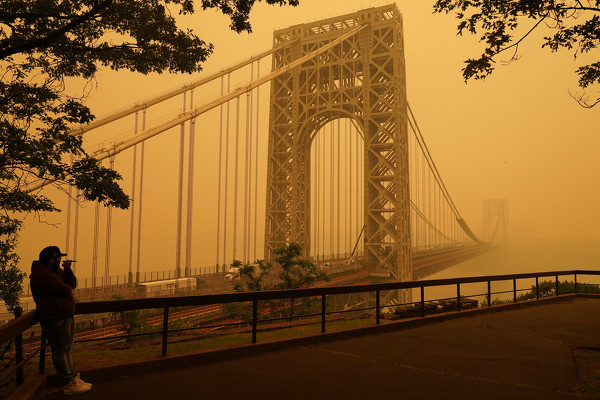
The yellowish haze was especially thick at the George Washington Bridge in Fort Lee, N.J., on Wednesday.
CELINA - Smoke from Canadian wildfires made its way to Ohio, prompting the Ohio Environmental Protection Agency to issue the first-ever statewide air quality advisory on Wednesday.
The smoke was visible in Mercer and Auglaize counties.
"You look outside, it looks a little hazy, that's what that is," said Mercer County Emergency Management Agency Director Mike Robbins. "There's a few clouds but if you just look off toward the horizon, you don't have to look very far and it looks hazy down toward the ground. That's the smoke. It's here."
Robbins said he heard reports of people actually smelling the smoke in parts of the East Coast. That's not the case locally, he added.
"We've got the haziness as well. The haziness is coming from the forest fires, the smoke, from up by Nova Scotia, Canada area," said Auglaize County EMA Director Troy Anderson. "With the upper jet stream, it's bringing it down this way."
Robbins' office didn't field any calls regarding the smoke on Wednesday. Also, Anderson said he hadn't heard of anyone getting sick or having difficulty breathing because of the smoke.
Ohio EPA issued a statewide air quality advisory as smoke from Canada's wildfires continued to adversely impact air quality, said spokesperson James Lee. He confirmed this was the first time OEPA had issued such an advisory for the entire state.
"It was based on the smoke from the Canadian wildfires and the readings on the monitors throughout the state," Lee said.
The state agency expected the Air Quality Index to be unhealthy for certain groups on Wednesday.
"When air quality is in this range, people who are in sensitive groups (due to medical conditions, exposure conditions, or innate susceptibility) may experience health effects during outdoor activities," an Ohio EPA news release reads. "To decrease the potential for health issues, sensitive groups of people (children, elderly, people with asthma or COPD) should limit prolonged or strenuous outdoor activity."
Particulate levels are expected to remain elevated through today.
"Ohio EPA will assess the data (this) morning to make a determination whether or not the advisory needs to be extended," Lee said.
Smoke from forest fires outside of Ohio has reached the area before, Robbins and Anderson said.
"This has happened a couple years back when the wildfires out west were prevalent," Anderson said.
"But usually by the time it gets here it's way up higher. It's not coming down to the ground (like on Wednesday)," Robbins said.
NEW YORK (AP) - Intense smoke blanketed the northeastern United States for a second day Wednesday, turning the air a yellowish gray and prompting warnings for people to stay inside and keep windows closed. The smoke was flowing from dozens of wildfires in several Canadian provinces.
Much of the air was in the "unhealthy or worse categories in areas from the mid-Atlantic through the Northeast and parts of the Upper Great Lakes," according to an advisory issued by the Environmental Protection Agency Wednesday night.
U.S. authorities issued air quality alerts in multiple regions and smoke was expected to persist for days.
Conditions were especially bad in parts of central New York, where the airborne soot was at hazardous levels. In New York City, officials on Wednesday said everyone should stay indoors. The conditions arrived late Tuesday afternoon, obscuring views of New Jersey across the Hudson River.
Here's a closer look at what's happening and what's in the smoke:

In this GeoColor satellite image taken Monday, smoke from wildfires burning in Quebec, Canada, top center, drifts southward.
Unusually hot, dry weather that wouldn't stop gave rise to the wildfires.
"The month of May was just off the charts - record warm in much of Canada," said Eric James, a modeling expert with the Cooperative Institute for Research in Environmental Science at the University of Colorado, who is also with the National Oceanic and Atmospheric Administration.
A warming planet will produce hotter and longer heat waves, making for bigger, smokier fires, according to Joel Thornton, professor and chair of the department of atmospheric sciences at the University of Washington.
The Quebec-area fires are big and relatively close, about 500 to 600 miles from Rhode Island and they followed wildfires in Nova Scotia.
"I don't remember fires of this scale in the last 10 years," James said of the Quebec blazes.
Smoke from fires in western Canada have been drifting into the United States for weeks. But it's recent fires in Quebec that have produced the dangerous east coast haze.
Strong winds high up in the atmosphere can transport smoke long distances and it's common for large, violent fires to create unhealthy conditions hundreds of miles away from where forests are burning.
But the right mix of circumstances had to align for the smoke to blanket major U.S. cities: A dry, hot spring set the stage. Then weather did the rest, said Bob Henson, meteorologist with Yale Climate Change Connections.
In Canada, air is circulating counterclockwise around a low pressure system near Nova Scotia. That sends air south over the fires in Quebec. There the air picks up smoke, and then turns east over New York state, carrying smoke to the eastern seaboard.
"It's a simple matter of trajectory," Henson said. "The smoke goes where the wind takes it."
This wind pattern isn't particularly rare. But the confluence of events is.
"The timing of this weather patterns is unfortunately overlapping with a situation that was ripe for large fires," Thornton said.
Weather patterns change and the worst conditions should only last a day or two. Some smoke, however, could linger for a week or more, according to James.

The sun rises over a hazy New York City skyline as seen from Jersey City, N.J., on Wednesday. Intense Canadian wildfires are blanketing the northeastern U.S. in a dystopian haze, turning the air acrid, the sky yellowish gray and prompting warnings for vulnerable populations to stay inside.
Although smoke seems familiar, it is actually made up of a complex mix of shapes, from round to corkscrew-shaped under the microscope.
"It's not just one sort of chemical," said Rima Habre, an expert in air quality and exposure science at the University of Southern California. "It could have gases and carbons and toxic metals." As it travels, Habre said, it also changes and can contain ozone.
Much of what we see in the air and measure is small particles, or PM 2.5. These are so small they can get deep into the lungs, where oxygen enters your circulation.
"Mostly we worry about inflammation in the lungs," Habre said, from these high levels of pollution. But with climate change amping up fires, increasingly, she said, she is worried about broader numbers of people being exposed to less extreme smoke for weeks or months.
"Most healthy adults and children will recover quickly from smoke exposure and will not have long-lasting health effects," according to the EPA advisory. But that is less true for a large category of people, including children whose lungs are still developing, older adults, and people with lung diseases, such as asthma and chronic obstructive pulmonary disease.
Stay inside, keeping your doors, windows and fireplaces shut, is the advice. Air conditioning on the recirculation setting can help filter out some particles, and air filters can remove many more.

